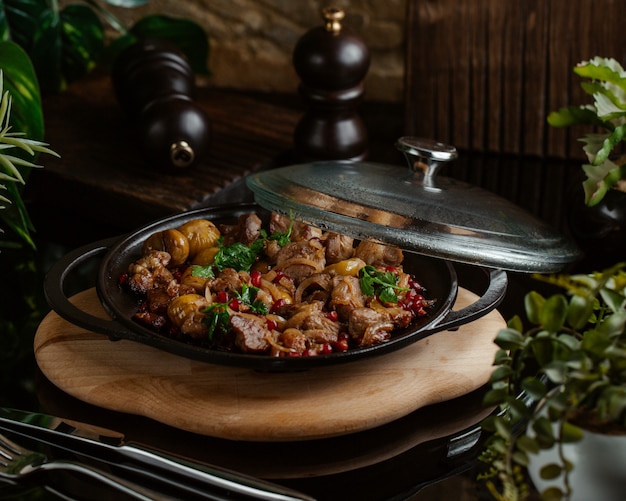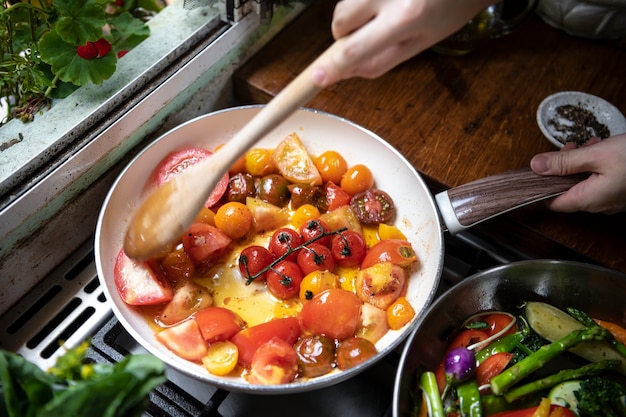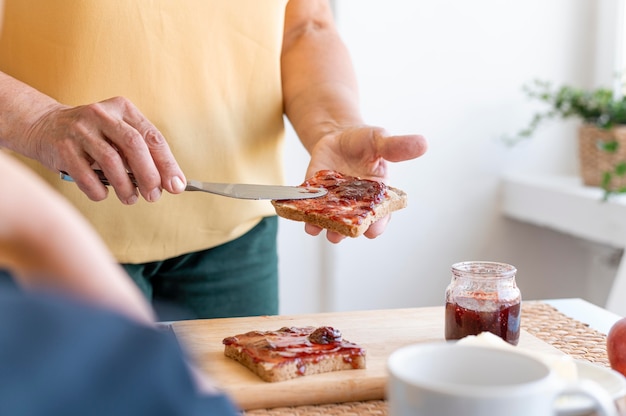Oh, corned beef. Just the thought of it sends my taste buds into overdrive. It's a classic, a comfort food, a dish that instantly transports me back to my childhood, to family gatherings where the aroma of slow-cooked beef filled the air, promising a feast fit for a king (or at least, a very hungry family).
Over the years, I've perfected my corned beef slow cooking technique, and I'm here to share my secrets with you. It's not just about throwing a hunk of meat in a pot and letting it simmer, it's about mastering the art of slow cooking to create that perfect melt-in-your-mouth texture that'll have everyone begging for seconds (and maybe even thirds!).
Let's dive in and discover the perfect slow-cooking times for achieving that melt-in-your-mouth, fork-tender corned beef masterpiece.
(Part 1) The Magic of Slow Cooking

Now, I know what you might be thinking: "Slow cooking? Isn't that just for, like, a Sunday roast?" And while it's certainly a classic way to enjoy a Sunday dinner, slow cooking is so much more than that. It's a versatile technique that unlocks a whole new level of flavour and tenderness, especially for tougher cuts of meat like corned beef. You can even use it to create delicious pulled pork or fall-off-the-bone ribs.
Understanding the Science Behind Slow Cooking
Let me break it down for you. When you slow cook meat, you're essentially giving those tough muscle fibres a long, gentle massage. The low and slow heat breaks down the collagen, turning it into gelatin, which gives the meat that melt-in-your-mouth texture we all crave. It's like a magic potion for meat, turning tough cuts into juicy, flavourful masterpieces.
Think of it this way: imagine a piece of meat as a tightly wound ball of yarn. Slow cooking is like gently unraveling that ball, allowing the individual threads to loosen and become more pliable. This creates a tender, succulent texture that melts in your mouth.
(Part 2) The Perfect Cut: Choosing Your Corned Beef

To embark on this slow cooking journey, you need the right ingredient – a beautiful, brined corned beef. Now, I'm not talking about those thin slices you get at the deli. We're going for a whole brisket, ideally about 3-4 pounds, which gives you plenty of delicious meat to share.
What to Look For in a Quality Brisket
When selecting your corned beef, look for a cut that's evenly marbled with fat. That fat is your friend – it'll melt during cooking, creating a rich, juicy flavour. The brisket should also be firm to the touch, with a bright red colour. Avoid any cuts that have a dull or discoloured appearance.
If you're a bit intimidated by a whole brisket, don't worry! You can also use a flat cut, which is a thinner piece of the brisket, perfect for smaller gatherings or if you're looking for a quicker cooking time. Flat cuts tend to be leaner, so be sure to keep an eye on them during cooking to avoid drying them out.
(Part 3) The Essential Prep: Setting the Stage for Success

Before you even think about firing up the slow cooker, there's a little bit of prep work to do. It's not complicated, just a few steps to set you up for success.
Pat It Dry: Ensuring Even Browning
First, pat your corned beef dry with paper towels. This helps to ensure even browning and prevents the meat from steaming rather than roasting. A dry surface allows the meat to develop a beautiful, crispy crust as it cooks.
Season It Up: Adding Your Personal Touch
Now, it's time to add some flavour! While the corned beef is already seasoned from the brining process, a little extra spice never hurts. I like to add a generous sprinkle of black pepper, a pinch of garlic powder, and a touch of paprika for a smoky depth of flavour. But feel free to experiment with your own favourite spice blends! You can use a blend of allspice, cinnamon, cloves, and mustard seed for a more complex flavour profile. Some people even like to add a pinch of red pepper flakes for a touch of heat.
Don't be afraid to get creative and experiment with different seasonings! You can use a pre-made spice blend or create your own. This is where you can truly personalize your dish.
(Part 4) The Slow Cooker Symphony: Orchestrating the Perfect Meal
Here's where the magic truly begins. Your slow cooker is the conductor of this culinary symphony, gently coaxing the corned beef into a state of melt-in-your-mouth perfection. It's a slow and steady process, but the results are well worth the wait.
Layering the Flavour: Building a Delicious Broth
First, place the corned beef in the slow cooker. Next, add your choice of vegetables. I love to use a medley of carrots, onions, and potatoes, but you can also add other favourites like celery, parsnips, or even leeks. The vegetables will not only add flavor to the broth, but they'll also become incredibly tender and delicious after cooking for hours.
Now, it's time to add the liquid. This is where I like to get creative. You can use plain water, beef broth, or even a mix of both. For extra flavour, I add a splash of apple cider vinegar, which helps to tenderize the meat and adds a touch of sweetness. A cup of beer also gives the broth a nice depth of flavour, especially if you use a dark beer like stout or porter.
The liquid you choose will greatly influence the final flavour of your corned beef, so don't be afraid to experiment with different combinations until you find what you like best.
The Importance of Temperature: Low and Slow is the Key
Finally, set your slow cooker to low. I know, you might be tempted to crank up the heat, but trust me on this one. Low and slow is the key to unlocking that tender, juicy texture. High heat will cook the meat too quickly, resulting in a tough and dry final product.
Think of it like baking a cake. You wouldn't bake a cake on high heat, right? You'd bake it slowly and gently to allow the batter to rise and cook evenly. The same principle applies to slow cooking corned beef.
(Part 5) The Waiting Game: Patience is a Virtue
Now, comes the most challenging part of the whole process: waiting! The cooking time will vary depending on the size of your corned beef and the heat setting of your slow cooker. But here's a general guide:
A Timeline for Tenderness: Understanding Cooking Times
For a 3-4 pound brisket, I usually cook it on low for 8-10 hours. If you're using a flat cut, you can reduce the cooking time to 6-8 hours. Remember, the goal is to cook the corned beef until it's incredibly tender and falls apart easily.
Here's a helpful tip: If you're short on time, you can cook the corned beef on high for a shorter period, but it won't be as tender. For a 3-4 pound brisket, cook on high for 4-6 hours.
The waiting time may seem long, but trust me, it's worth it. You'll be rewarded with a truly melt-in-your-mouth masterpiece.
(Part 6) Checking for Perfection: The Fork Test
Patience, my friend, patience. The anticipation is almost as good as the meal itself. After the cooking time is up, resist the urge to immediately carve into the meat. It's crucial to give the corned beef a good rest.
The Fork Test: Ensuring Tenderness
The best way to know if your corned beef is done is to use the fork test. Gently insert a fork into the thickest part of the meat. If it slides in effortlessly and the meat falls apart easily, you know it's ready.
If the fork encounters resistance, give the corned beef another 30 minutes or so of cooking time. Don't worry, it's better to err on the side of caution and ensure your corned beef is perfectly tender.
(Part 7) The Grand Finale: Unveiling Your Masterpiece
Finally, the moment of truth! It's time to unveil your slow-cooked masterpiece and enjoy the fruits of your labour. All that patience will pay off in a delicious, satisfying meal.
The Carving Ceremony: Transforming Tender Meat into Delicious Bites
Using two forks, gently lift the corned beef out of the slow cooker. Carefully transfer it to a cutting board and let it rest for about 10 minutes. This allows the juices to redistribute, ensuring a moist and tender cut.
Once the corned beef has rested, slice it against the grain into thin, even pieces. This technique ensures that each bite is tender and juicy. If you slice with the grain, the meat will be tougher and less enjoyable to eat.
Serving Suggestions: Creating a Feast
Now, it's time to assemble the ultimate corned beef feast! Here are some of my favourite ways to serve this slow-cooked delight:
- Classic reuben sandwich: Pile high with corned beef, sauerkraut, Swiss cheese, and Thousand Island dressing on toasted rye bread. This is a classic for a reason!
- Corned Beef Hash: Dice the corned beef and sauté it with potatoes, onions, and peppers. Top with a fried egg for a hearty and satisfying meal.
- Corned Beef and Cabbage: This traditional pairing is a must-try! Serve the corned beef with boiled cabbage and a dollop of mustard.
- corned beef tacos: Warm tortillas and fill them with shredded corned beef, salsa, guacamole, and sour cream. It's a delicious twist on a classic!
- Corned Beef Salad: Combine shredded corned beef with chopped vegetables, a tangy dressing, and a sprinkle of cheese. It's a refreshing and light way to enjoy this hearty meat.
Don't be afraid to get creative with your serving ideas! You can use the corned beef in any recipe that calls for roast beef or shredded meat.
(Part 8) Beyond the Feast: Leftover Love
Don't be afraid of leftovers! They're an opportunity for more delicious meals. Slow-cooked corned beef is even better the next day because the flavors have had time to meld and intensify.
Make it a Meal: Reheating and Repurposing
Here's a little secret: slow-cooked corned beef gets even better the next day. Refrigerate the corned beef in its cooking liquid for up to 3 days. You can reheat it in the oven or microwave, or even enjoy it cold in sandwiches or salads.
Leftover Inspiration: Creative Ways to Use Leftovers
Here are some delicious ways to use your leftover corned beef:
- corned beef soup: Make a hearty soup by adding the leftover corned beef and vegetables to a pot of broth. Simmer until everything is heated through and serve with crusty bread.
- Corned Beef Pizza: Spread a thin layer of tomato sauce on a pizza crust, top with shredded corned beef, sauerkraut, and Swiss cheese. Bake until the cheese is melted and bubbly.
- Corned Beef Hash with a Twist: Use the leftover corned beef to make a flavorful hash. Add some diced potatoes, onions, and peppers, and top with a fried egg or a dollop of sour cream.
- Corned Beef Quesadillas: Warm tortillas and fill them with shredded corned beef, cheese, and your favorite toppings.
- Corned Beef Dip: Combine shredded corned beef with cream cheese, sour cream, and your favorite seasonings. Serve with crackers, vegetables, or bread.
Don't let leftovers go to waste! Get creative and enjoy the delicious flavors of corned beef in new and exciting ways.
(Part 9) Tips and Tricks: Mastering the Art of Slow Cooking
Over the years, I've learned a few tricks that make slow cooking corned beef even easier and more delicious.
The Deglazing Technique: Transforming Pot Scraps into Rich Gravy
After you remove the corned beef from the slow cooker, don't throw away the flavorful cooking liquid! Instead, use it to make a rich and delicious gravy. Scrape the bottom of the slow cooker to loosen any browned bits, then pour in a little flour and whisk until smooth. Gradually add some of the cooking liquid, whisking constantly until the gravy thickens. You can also add a splash of Worcestershire sauce for extra depth of flavour. This technique transforms the leftover bits of flavor into a delicious gravy that complements the corned beef perfectly.
The Power of Pressure: A Faster Way to Tenderize
If you're short on time, you can use a pressure cooker to cook your corned beef. It'll be ready in just 1-2 hours. But be warned: the texture might be a little less melt-in-your-mouth compared to slow cooking. Pressure cooking tends to create a more tender, but less "fall-apart" texture. If you're looking for a quick and easy way to prepare corned beef, a pressure cooker is a great option.
(Part 10) FAQs: Answering Your Questions
Got questions? I've got answers! Here are some frequently asked questions about slow cooking corned beef:
1. Can I Freeze Cooked Corned Beef?
Yes, you can freeze cooked corned beef for up to 3 months. Wrap it tightly in plastic wrap and foil, then store it in a freezer-safe bag or container. When you're ready to enjoy it, thaw the corned beef in the refrigerator overnight.
2. What if the Corned Beef Is Too Salty?
Don't worry, it's a common problem! You can reduce the saltiness by rinsing the corned beef under cold water before cooking. If it's still too salty, you can simmer the corned beef in fresh water for 30 minutes before adding the other ingredients to the slow cooker. This will help to draw out some of the excess salt.
3. Can I Use a Crock-Pot Instead of a Slow Cooker?
Absolutely! Crock-Pots and slow cookers are essentially the same thing, so you can use either one to prepare your corned beef. They both operate on the same principle of low and slow cooking.
4. What Can I Do with the Leftover Cooking Liquid?
The leftover cooking liquid is packed with flavour! Use it to make soups, stews, or even gravy. You can also freeze it for later use. The liquid is a great way to add depth of flavor to other dishes.
5. Is Slow Cooking Corned Beef Really Worth It?
Let me tell you, it is absolutely worth it! The slow cooking process creates the most tender, flavourful corned beef you've ever tasted. It's a meal that will impress your guests and leave everyone wanting more. The tender texture and rich flavor are unmatched, making it a truly satisfying experience.
I hope this comprehensive guide helps you master the art of slow cooking corned beef. With a little patience and the right techniques, you'll be able to create a delicious and memorable meal that everyone will love.
Everyone is watching

Prime Rib Roast Cooking Time Chart: Per Pound Guide
Cooking TipsPrime rib roast. Just the name conjures images of lavish dinners, crackling fires, and hearty laughter. It’s ...

How Long to Bake Potatoes in the Oven (Perfect Every Time)
Cooking TipsBaked potatoes are a staple in my kitchen. They're incredibly versatile, delicious, and surprisingly easy to m...

Perfect Rice Every Time: The Ultimate Guide to Cooking Rice
Cooking TipsAs a self-proclaimed foodie, I've always been a bit obsessed with rice. It's the foundation of countless cuisi...

The Ultimate Guide to Cooking Asparagus: Tips, Techniques, and Recipes
Cooking TipsAsparagus. The mere mention of this spring delicacy conjures up images of vibrant green spears, crisp and burs...

Ultimate Guide to Cooking the Perfect Thanksgiving Turkey
Cooking TipsThanksgiving. Just the word conjures up images of overflowing tables laden with delicious food, the scent of r...
